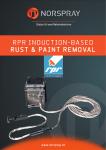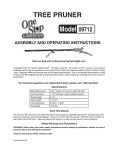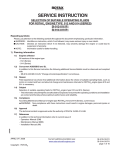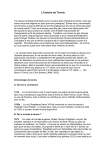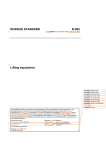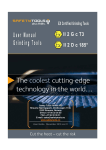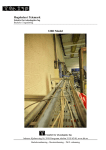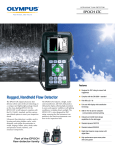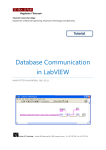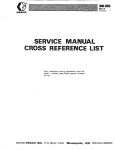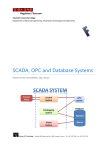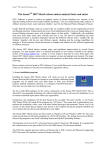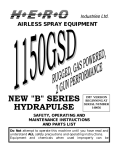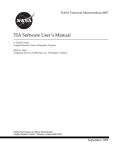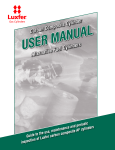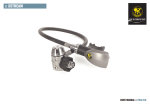Download RPR Induction-based rust & paint removal
Transcript
RPR Induction-based rust & paint removal The innovative RPR Rust & Paint Removal System is a highly cost-effective and extremely efficient method for removing paint and corrosion products from steel surfaces. This patented system is based on induction heating - a proven, reliable technology that has been further developed by RPR Technologies AS. The RPR system delivers a cost-saving and environmentally friendly method of surface preparation: • EXTREMELY FAST COATINGS REMOVAL • NO NOISE • NO ABRASIVES OR WATER • REMOVES DIFFICULT COATINGS • NO DUST • CLEAN & SAFE RPR Technologies Induction-based rust & paint removal The RPR concept RPR removes paint, coatings, thick rust, bacterial corrosion and oil & grease residues from electrically conductive surfaces (steel, etc.) by breaking the interfacial bonding between the material to be removed and the substrate using controlled, localized induction heating with a minimum consumption of energy. The principle of induction heating The RPR induction generator sends alternating current through an induction coil, which generates an electro-magnetic field. This magnetic field induces eddy currents in a conductive material like steel. Due to the resistance of the steel, these currents are converted to heat = induction heating. The heat is generated below the coating, resulting in quick and clean disbonding. The RPR system is ideal for the removing paint, rust, and other coatings (vulcanized rubber, fire protectant, epoxies, etc. with control possibilities for the following functions: • • • • Energy consumption Disbonding temperature range Heat penetration Removal speed With above setting possibilities, RPR delivers unequalled performance and is the system of choice for cost-effective, safe and environmentally friendly surface coating removal from steel substrates. RPR is ideal for: marine, tanks, offshore and land-based pipelines 2 Induction-based rust & paint removal RPR Technologies How does it work? Main Induction Unit (220 kg.) Induction unit & head (many sizes available) Extention cable (max.100 m) Connector (transformer) box The basic components needed for RPR surface preparation are: • AC power supply • The patented RPR system, consisting of the RPR induction generator unit an intermediate transformer the RPR inductor hand-held unit induction coil (paint stripping head system cables with water cooling • An electrically conductive work piece (i.e., the steel surface to be treated) While the system is activated, the power supply sends alternating current through the heating coil, generating an electromagnetic field and inducing eddy currents within the work piece, giving precisely controlled amounts of clean, localized heat without any physical contact between the inductor head and the work piece (no wear and tear). This controlled, localized heating causes instant disbonding of coatings and rust (or mill scale) beneath the inductor head position. The heating pattern is always the same for a given set-up, ensuring consistency and optimizing the resulting surface treatment quality. When activated, the process starts instantly, inducing heat in the work piece immediately achieving control of the disbonding temperature level within milliseconds. The RPR induction heating is highly directional: a very small area of the work piece, limited to the position of the inductor stripping head, is induction heated without affecting surrounding areas. Power input is controlled automatically to achieve the temperature range required for slower or faster heating and disbonding. 3 RPR Technologies Induction-based rust & paint removal RPR induces heat (energy) only where and when it is needed. As induction heating by itself does not produce harmful emissions, smoke, loud noise or waste heat, and there is no negative impact on the surrounding environment. RPR uses only 25% of the energy per surface unit required for conventional methods: Power consumption RPR abrasive blasting / water jetting kWh per m2 0.75 3.00 kWh per ft2 0.07 0.28 The energy-efficient RPR process converts over 90% of the energy expended into useful heat. This represents a much higher efficiency rating than is possible with conventional surface preparation methods. The results are reduced costs and time savings. Stand-by heat loss is reduced to a minimum, since the heat is only “active” while the system is actually working, i.e. performing its task. There is a correlation between the frequency of the electromagnetic field and the heat penetration in the work piece: ■ higher frequency = less penetration ■ lower frequency = more penetration ■ this function can be controlled with the RPR system RPR can be pre-set by the operator to achieve repeatable optimum performance, depending on the condition of the surface to be treated, the material to be removed and other applicable specifications. RPR - Rust & Paint Removal by localized induction heating The inductor head generates the electromagnetic field and is moved by the RPR operator over the surface to be treated. At the position of the inductor head, the steel reaches the required, pre-set temperature range within milliseconds. This causes instant disbonding between paint, rust, mill scale, etc. With the induction heat penetrating only 0.3 mm into the substrate, paint and rust will be disbonded on the treated side of the object, while any coating on the reverse side will not be damaged or affected at all. Paint, rust, mill scale etc. come loose and can easily be peeled off or removed otherwise with scraper tools or similar equipment. Oil and grease residues present on the surface will also be removed by RPR induction heating. A general recommendation is that steel objects to be RPR induction-treated should have a minimum thickness of 5 mm (slightly less than ¼”). RPR has been tested on steel plates of 3 mm thickness (just under 1/8”). The coatings removal was a success, but RPR recommends that operators themselves run trial tests on all steel less than 5mm before full coatings removal jobs. 4 Induction-based rust & paint removal The ■ ■ ■ RPR Technologies image below shows how the RPR system disbonds coatings: inductor head (yellow) at a distance of 3-5 mm (1/8” - 1/4”) from the surface disbonding (white) occurs between the paint (blue) and the steel (grey) induction heating (red area) with penetration of approx. 0.3 mm (1-2 mils) INDUCTOR HEATED AREA DISBONDING PAINT Rust & Paint Removal – fast, environmentally friendly and low-cost STEEL RPR testing - in the lab and in the field RPR has been field-tested extensively in Europe and SE Asia over a period of 18 months and has proven to be highly efficient as well as very reliable. It has no moving parts and requires very little maintenance. A research and test program by the Norwegian National Institute of Technology has shown conclusively that electromagnetic emission from all parts of the RPR equipment are far below the established limits for operator and equipment safety. The emissions of potentially irritant or hazardous fumes (caused by heat transfer from the steel to the coating) remain far below the applicable safety limits. Paint residues and fumes can be collected with standard “off the shelf” equipment. Testing has also shown that the temperature gradients remain far below the applicable safety limits for structural integrity of steel. A temperature range of between 150° and 200° C is ample to cause disbonding of rust, mill scale and most paints and coatings. The graph shows the temperatures induced with RPR in 3 positions, against time lapsed, in a 5 mm thick low-carbon steel plate, at 50 kW energy load: 1. upper curve 2. middle curve 3. lower curve = RPR-treated surface = at 2.5 mm depth = at 5 mm (backside) 200° C (upper curve) is reached within 0.3 seconds. At 2,5 mm penetration, the temperature is then only 50-60° C. At 5 mm depth (= untreated backside) hardly any temperature rise is detectable. 5 RPR Technologies Induction-based rust & paint removal RPR equipment set-up The system consists of a compact “Induction Generator”, featuring the unique, patented RPR control system enabling control of frequency, temperature and heat penetration. In addition, there is the special RPR handheld “Inductor Head”, equipped with 2 sensors regulating the temperature in relation to the speed of operator movement. The Inductor Head is connected to the Induction Generator with special cable packs featuring water cooling. Standard length of a cable pack is 20 m (66 ft), plus a whipend for easy operator handling of another 5 m (16 ft). It is possible to work with up to 5 cable packs plus the 5 m whip-end, allowing a work radius of up to 100 m (well over 300 ft) away from the Generator unit. In addition, power input cables of any preferred length can be used. Diagram of typical RPR Rust & Paint Removal system Cooling system The RPR system features water cooling for the power cable packs and the inductor stripping head. The circuit is protected against “low water flow” by tripping sensors, with operator “re-set” at the stripping head position. The system requires 10 l/min. (2 US gallons/ min) of clean freshwater, at 4 bar. When working at a height of 20 m (66 ft) or more above the location of the main unit, the water pressure must be increased to 5 bar. Optionally, a “closed loop” cooling system can be supplied, equipped with its own water tank and circulation pump (no pressure regulation). A choice of various designs and cooling media is available, depending on the specific conditions at the job location. This option comes mounted as a “box” on the main unit, with inlet and return connections. If clean water is not available, the cooling system must be equipped with a special water filter - contact RPR Technologies for details. 6 Induction-based rust & paint removal RPR Technologies Various equipment and accessories RPR Induction Generator The physical size of the machine is quite small (800x600x800 mm) and the weight is approximately 220 kg (460 lbs). The machine is robustly built for site work: ■ aboard ships or on offshore rigs, ■ inside tanks or on floating roofs, ■ on or under bridges, etc. etc. The unit can be wheeled around but it can also be handled by forklift or crane. Standard RPR Inductor Body The standard hand-held inductor unit and a flat 20 cm wide coil head is supplied with all systems. Multiple coil heads can be ordered (see below) and an optional extention shaft will allow the operator to stand upright while rolling the coil head over horizontal surfaces. Many different inductor coil heads available RPR can provide an almost limitless range of special designs for the treatment of various diameter pipes, flanges, beams, corners, nuts and bolts, rivets etc. Changing the inductor heads takes only minutes. Contact RPR for more information regarding different coil head types and designs. Crawler system (this image is only an example) Inductor heads can easily be fitted to many standard robot and manipulator systems, similar to those used for dry abrasive blasting or UHP water jetting. Remote-controlled equipment for (semi)automatic applications is available in many different types and brands. Contact RPR for more information. Which coatings can be removed? RPR removes most types of coatings, including thick fireproofing, as well as thick types of rust. An exception is inorganic zinc (zinc-silicate) which requires a high disbonding temperature. As it is usually preferred to leave a good zinc-silicate intact rather than remove it and since it requires a temperature closer than desired to the level that may adversely affect steel properties, it is not recommended to use RPR for this application. 7 RPR Technologies Induction-based rust & paint removal The RPR system features temperature control settings - an iron oxide based primer and a chlorinated rubber coating have different disbonding temperature characteristics but can both be removed by RPR with equal ease. Vulcanized material or very thick, glued-on rubber linings can also quickly and easily be disbonded and removed. The same applies to powder coatings: always hard to remove, now “easy as pie’ with RPR. “Selective” coating removal is sometimes possible, depending on the material’s temperature characteristics and only “from the bottom” and up - the RPR process starting with induction heating of the steel substrate. Possible is for example: leave a zinc-silicate primer intact and remove other coating on top; or, leave an iron oxide primer intact while removing a bituminous coating on top. Images from typical RPR coating removal jobs 8 Chemical Tank - France, June 2007. Removing tank bottom lining. Fiberglass reinforced epoxy. 1500-2000 microns Aircraft Carrier - US, May 2007. Removing anti-skid deck coating. Epoxy with carborundum grit. 2000-3000 microns Naval Shipyard - US, January 2008. Removing various coatings including rubber and anti-skid. Offshore Oil Platform - North Sea, June 2007. Removing Chartek fire retardant. 8000-13000 microns. Railroad Bridge - UK, June 2007. Removing epoxy paint. 400-600 microns with iron oxide primer Ship Hull - Gothenberg, Sweden, February 2008. Removing epoxy coating. Induction-based rust & paint removal RPR Technologies Surface cleanliness RPR gives a surface cleanliness which depends on the condition of the surface to be treated and the type and condition of the coating to be removed. RPR will in most cases also clean the pores of the steel and even corrosion pittings. A heavily corroded surface, with a lot of rust, will usually give a lesser grade of cleanliness than a surface with little rust and still mostly covered with coating. When removing materials with thermoplastic properties, like chlorinated rubber or bituminous coatings, heat transfer from the steel will soften and even melt the underside of the coating. During the removal process, this slight “melt back” will often cause tiny paint particles to flow back into the pores and re-cure. These particles can subsequently not be removed by scraping and will show up as a very thin, visible residue, almost like a form of discolouration. If necessary, this residue can easily and quickly be removed by a dry or wet sweep blast (both with very low abrasive consumption) or by water jetting. Generally, RPR will give a visual grade of cleanliness in the range of commercial to near-white blast: ■ ISO Sa 2 to Sa 2,5 ■ SSPC - SP 6 to SP 10 ■ NACE # 3 to # 2 Epoxy tie coat + epoxy mastic + polyurethane topcoat (Norsok system 1) dft 350 micron (14 mils) - ISO Sa 2,5 / SSPC SP10 / NACE # 2 Surface profile Like UHP water jetting, RPR does not produce a “new” surface profile but it will bring back the profile as present under the coating prior to its removal. After-treatment Before application of certain coatings following RPR treatment, depending on job and product specifications, an after-treatment of the surface may be required: for example, a fast sweep blast to give a new surface profile or water washing to remove water-soluble salts. Many paint manufacturers however, now offer good surface-tolerant coatings that in many cases can be applied direct over RPR-treated surfaces without problem. If a sweep blast is done after RPR treatment, it will be obvious that abrasive consumption and related costs are very significantly reduced compared with a full dry blast from the start. 9 RPR Technologies Induction-based rust & paint removal Removal rates per hour 20 to 100 m2 (215 to 1076 ft2) At an energy output between 10 and 50 kW, RPR generally achieves paint and rust removal rates of 20-100 m2 per hour (215-1076 ft2). Productivity depends on the type and condition of surface to be treated as well as the type, condition and thickness of coating to be removed, as well as other variables. The following results were achieved in the field with fairly “difficult to remove” coatings, thickness range 400 to 500 microns (16-20 mils) and can be regarded as realistic: Energy output 10 kW 17 kW 25 kW 50 kW Removal rate per hour 20 m2 / 215 ft2 35 m2 / 377 ft2 40 m2 / 430 ft2 70 m2 / 753 ft2 With coating thicknesses of 300-500 microns (12-20 mils), RPR will usually show removal rates of between 20 and 100 m2 per hour (215-1076 ft2) at full energy output (50 kW). Maximum coating thickness that RPR will remove is in range of 20-30 mm (800-1200 mils). At very high thicknesses, removal speed and productivity will decrease. Figures are based on field results and will vary case-by-case, depending on a number of variables and job conditions. Working in confined spaces When working inside tanks or similar confined spaces, proper ventilation - as also customary for dry blasting - should be used. Paint disbonding by induction heating may cause irritating or hazardous fumes - therefore, the operator should always use respiratory protection when working in confined spaces. Removal of fire retardant coatings such as Chartek (from 8000 to 13000 microns) 10 Removal of hard and soft vulcanized rubber (from 12000 to 15000 microns) Induction-based rust & paint removal RPR Technologies Technical data Power supply Fusing Energy efficiency Cooling system Weight LxWxH 50 kW, 3-phase 360-500 V, 50/60 Hz Power source must be 3-phase 125 A fused Approximately 90% Water cooling (closed-loop cooling optionally available) min. 10 l/min clean freshwater (2.5 US gall) at min. 4 bar pressure 220 kg (460 lbs) 800 x 600 x 800 mm (32 x 24 x 32 in.) CE RPR is supplied with CE marking and Manufacturer’s CE Declaration of Conformity Warranty A 3-year warranty on defective parts and good workmanship is applicable, subject to proper handling, use and maintenance of the equipment by the user, in compliance with the relevant User Manual and Warranty Terms. RPR versus Conventional surface preparation Abrasive blasting and water jetting are established and excellent surface preparation methods, each with their specific characteristics and merits. RPR will not always be suitable to replace these methods. However, abrasive blasting will increase the waste mass and its related high collection and disposal costs by a factor of many times, while, depending on local conditions and regulations, water jetting often requires continuous pickup, decontamination and recycling of water. When and where the RPR system is suitable and appropriate, it offers significant economic, technical and environmental advantages. In general, thick and difficult to blast coatings are handled best with the RPR induction method. Productivity m2 per hr ft2 per hr Energy consumption kWh per m2 kWh per ft2 Waste / contamination Disposal cost Dust emission (dry) Water mist (WJ) Containment structure Noise level Safety - operator - other factors Environment Conventional low: 5 - 15 50 - 160 high: 3.00 0.28 medium to high medium to high medium to high medium to high expensive high: 112-115 dBA intrinsically unsafe intrinsically unsafe unfriendly / high costs RPR System high: 20 - 100 215 - 1076 low: 0.75 0.07 minimal to low mimimal to low zero - n/a zero - n/a zero - n/a practically silent intrinsically safe intrinsically safe friendly / minimal costs 11 Advantages of using RPR • • • • • • • • • • • • • • • • • • • • • RRP removes coatings 5-20x faster than conventional methods Production with 1 RPR unit approx. 5 to 100 m2 per hour, depending on conditions Practically noiseless - no nuisance to the surroundings No abrasive media - or significant reduction in case of sweep blast after-treatment Very little waste and disposal: only the removed paint and rust - minimal costs - environmentally friendly Complete removal - or with restrictions selective coat removal RPR-treated surfaces are suitable for application of most paint systems - especially surface-tolerant coatings No abrasive particle bounce-back No dust emission - no costly and time-consuming containment of structures -with dry sweep blast as after-treatment some dust emission will occur Other disciplines (welders, fitters, mechanics, electricians, etc.) can carry on working nearby Operator can use standard personal protection equipment as is customary for mechanical work - in confined spaces: respiratory protection and proper ventilation Safe for operator and surroundings - no known health or safety hazards Energy bonus - kWh per surface unit only 1/4 of conventional methods Can be used in wet environments and on wet surfaces - working in rain is no problem Inductor stripping heads in many shapes and sizes and for many applications Easily adaptable for (semi)automation with remote controlled robot or manipulator equipment No moving parts - hardly any wear and tear - practically maintenance-free No adverse effects on electric or electronic equipment such as: audio/video - computers - navigation equipment - measuring instruments - cathodic prot. systems CE-marking and Manufacturer’s CE Declaration of Conformity Warranty 3 years High production ensures fast turnaround, resulting in shorter downtime: lower costs per surface unit - lower total project costs Bottom-line economy for whom it really counts …for the contractor as well as the facility owner Summary With productivity often in excess of 5-10 times higher than conventional methods sometimes even better - RPR is fast, efficient and economic - a powerful and attractive alternative for the removal of coatings, linings and rust from steel surfaces: maintenance of ships, the offshore industry, land-based structures, bridges, cranes, pipelines, storage tanks, power stations, oil refineries, petrochemical plants, gas installations, etc. More information Please contact us for more information. RRP Technologies A/S Rolighetsvegen 7C 3933 Porsgrunn, Norway Tel.: +47 3560 3538 Fax: +47 6743 0057 www.rprtech.com












